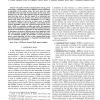Free Online Productivity Tools
i2Speak
i2Symbol
i2OCR
iTex2Img
iWeb2Print
iWeb2Shot
i2Type
iPdf2Split
iPdf2Merge
i2Bopomofo
i2Arabic
i2Style
i2Image
i2PDF
iLatex2Rtf
Sci2ools
TWC
2008
2008
A Queue-Based Approach to Power Control in Wireless Communication Networks
In modern wireless communication systems, power control plays a fundamental role for efficient resource utilization, in particular in the systems where the users share the same bandwidth at the same time. In such systems, in fact, many users transmit over the same radio channel using the same frequency band and time slots so that the signal of an individual user becomes interference for the other users. Hence the transmission power levels need to be smartly manipulated so as to achieve an adequate quality of service for as many users as possible and, thus, an efficient network utilization. Conventional power control algorithms adopt the Signal-to-Interference-plus-Noise Ratio (SINR) as controlled variable and neglect the important effects of the manipulated control variables (transmission powers) and of the retransmission mechanism on the queueing dynamics. In this paper, we pursue a different queue-based approach which takes into account the queueing dynamics and adopts the queue size...
| Added | 16 Dec 2010 |
| Updated | 16 Dec 2010 |
| Type | Journal |
| Year | 2008 |
| Where | TWC |
| Authors | Luigi Chisci, Romano Fantacci, Lorenzo Mucchi, Tommaso Pecorella |
Comments (0)

